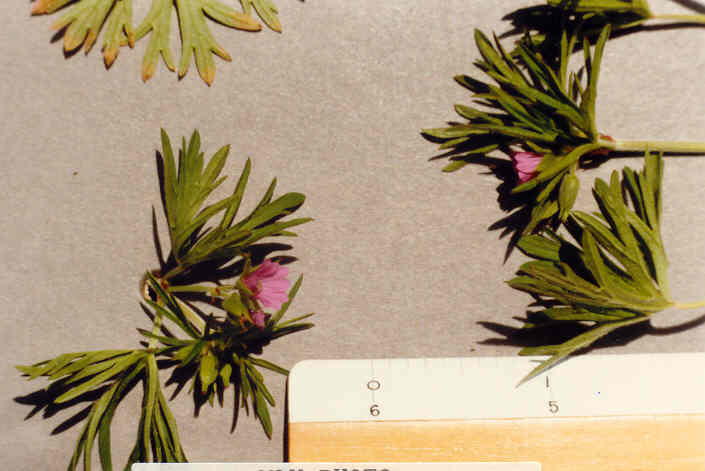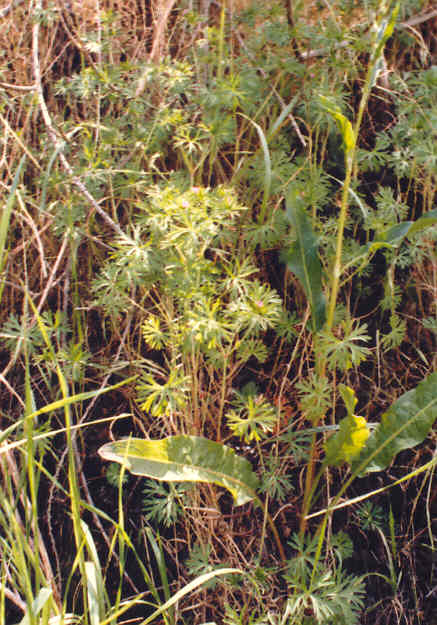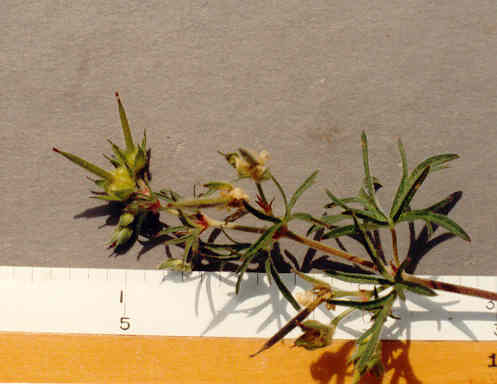
Geranium dissectum L.
 |
Geranium dissectum L.
Geraniaceae (Geranium Family)EuropeCranesbillCut-Leafed GeraniumCommon Geranium |
May Photo
Plant Characteristics:
Usually freely branched annual, 3-6 dm. high, retrorsely pubescent; lvs. 3-6 cm.
broad, deeply 5-parted, the divisions again divided into broadly linear acute
segms.; peduncles mostly 2-fld.; pedicel 2-10 mm. +/- = fl., hairs glandular;
sepals awn-tipped, 5-7 mm. long; petals rose-purple, equaling sepals;
style-column ca. 12 mm. long including the 2 mm. beak; carpel bodies 2-2.5 mm.
long, with stiff spreading hairs; seeds strongly reticulate, with unequally
thick-walled pits.
Habitat:
Waste and open places; mostly below 3000 ft.; widely distributed but not
common in S. Calif.; to Atlantic Coast. March-May.
Name:
Greek, geranos, crane, from the
beaklike fruit. Munz, Flora So. Calif. 491). Greek,
dis, prefix meaning two and Latin, sectus,
cleft. (Jaeger 80,234). Refers to the 5 parted lvs. which are again divided into
segms.
General: Occasional in the study in the sense that it is found in only a few places, one being on a shady north facing bank at the southerly end of the burn area below Eastbluff. There is a large colony of the species at this location. In 1999 the species was found on the bay side of Back Bay Drive about 3/8 of a mile southerly of this location. In 2004 the plant was found again in a grassy area on the bay side of Back Bay Dr. below Eastbluff North and in 2005 at the northerly end of Big Canyon. (my comments). Geraniums are of some value as forage, especially in the spring, when the herbage is grazed by sheep. They are not usually eaten by other livestock. (Robbins et al. 277). All true geraniums form seed bundles that resemble a thick needle or a crane's bill. Geranium should not be picked for medicinal purposes before flowering since the immature plants are almost indistinguishable from young Larkspur or monkshood, both dangerous but with very dissimilar flowers. G. caespitosum and several other true geraniums are used as an astringent, owing its effects to tannins and gallic acid. Like most astringents it needs direct contact with the inflamed or bleeding surface to be effective. (Moore, Medicinal Plants of the Mountain West 68). A decoction of Cranesbill, Geranium species, has been used as a gargle since Colonial times, when the Indians revealed the valuable properties of this root. Cranesbill was extolled in practically all early American herbals. Doctor W. Darlington, wrote in 1859--"Cranesbill root is powerfully astringent, without bitterness or unpleasant taste. Boiled in water and mixed with sugar and milk it is easily administered to children." (Meyer 208). About 250 species of temperate regions around the world, some weedy annuals, a few of the perennials cultivated. (Munz, Flora So. Calif. 491
Text Ref:
Jepson 589; Hickman, Ed. 673; Munz, Flora
So. Calif. 492; Roberts 26.
Photo Ref:
April-May 86 # 7,8,9; May 2 87 # 19A.
Identity: by R. De Ruff,
confirmed by F. Roberts.
First Found: April 1986.
Computer Ref: Plant Data 93.
Have plant specimen.
Last edit 5/13/05.
 |
 |
April Photo May Photo